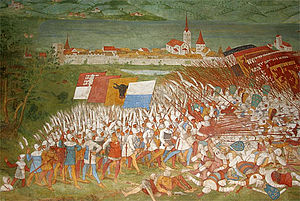Battle of Sempach
| Battle of Sempach | |||||||
|---|---|---|---|---|---|---|---|
| Part of the expansion of the Swiss Confederation | |||||||
 The battle scene in the fresco in the battle chapel at Sempach. 1886 restoration of a 17th-century painting, which was in turn based on a 16th-century work. |
|||||||
|
|||||||
| Belligerents | |||||||
|
|
|||||||
| Commanders and leaders | |||||||
|
|
Johann von Ochsenstein † Johann von Waldburg † |
||||||
| Strength | |||||||
| ca. 6,000-8,000 | ca. 4,000, including 1,500 knights | ||||||
| Casualties and losses | |||||||
| ca. 200 800 mercenaries |
ca. 1,500, among them ca. 400 noblemen | ||||||
The Battle of Sempach was fought on 9 July 1386, between Leopold III, Duke of Austria and the Old Swiss Confederacy. The battle was a decisive Swiss victory in which Duke Leopold and numerous Austrian nobles died. The victory helped turn the loosely allied Swiss Confederation into a more unified nation and is seen as a turning point in the growth of Switzerland.
During 1383 and 1384, the expansion of the Old Swiss Confederacy collided with Austrian interests. The interests of Austria were further undermined in the Pact of Constance, a union of Zürich, Zug, Solothurn and 51 cities of Swabia. In 1385, there were various attacks, without formal declaration of war or central organization, by forces of Zürich, Zug and Lucerne on the Austrian strongholds of Rapperswil, Rothenburg Cham and Wolhusen.
In January 1386, Lucerne expanded its sphere of influence by entering pacts with a number of towns and valleys under Austrian control, including Entlebuch, Sempach, Meienberg, Reichensee and Willisau. This move was the immediate cause of war. A local Austrian force defeated the confederate garrison at Meienberg. On 14 January, Lucerne called the confederaces for assistance. An armistice was called on 21 February, and negotiations were held in Zürich. But neither side had any real interest in ending the conflict at this point, and as the armistice ended, the conflict escalated into a full-scale military confrontation.
Duke Leopold gathered his troops at Brugg, consisting of his feudal vassals from Swabia, the Alsace, Aargau, Thurgau, Tyrol, as well as bourgeois forces of various towns and Italian, French and German mercenaries. In the course of a few weeks, no less than 167 noblemen, both secular and of the church, declared war on the Swiss. These declarations were sent to the Swiss diet in 20 packets, in order to increase the effect of shock. On 24 June, a messenger from Württemberg brought 15 declarations of war. Before all letters had been read, the messenger from Pfirt delivered another eight, and before he had finished speaking, letters from the lords of Schaffhausen were brought in. Another eight messengers arrived on the following day.
...
Wikipedia
